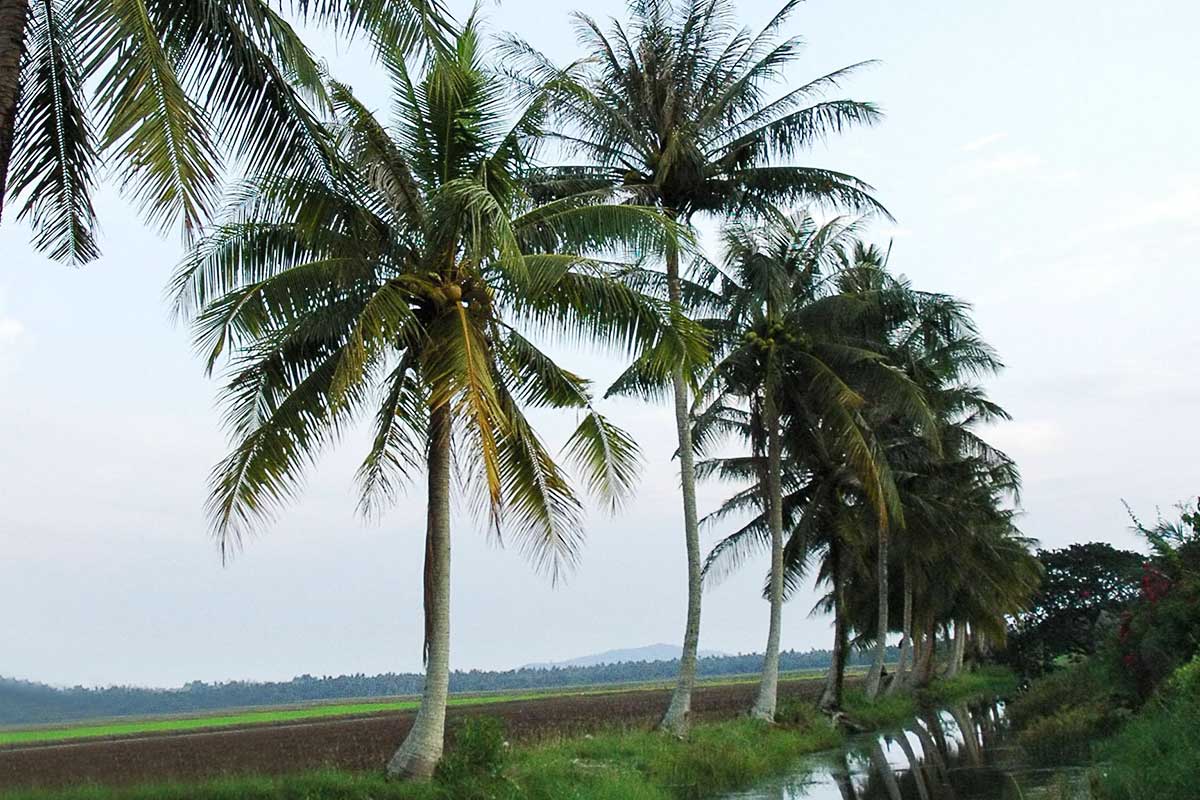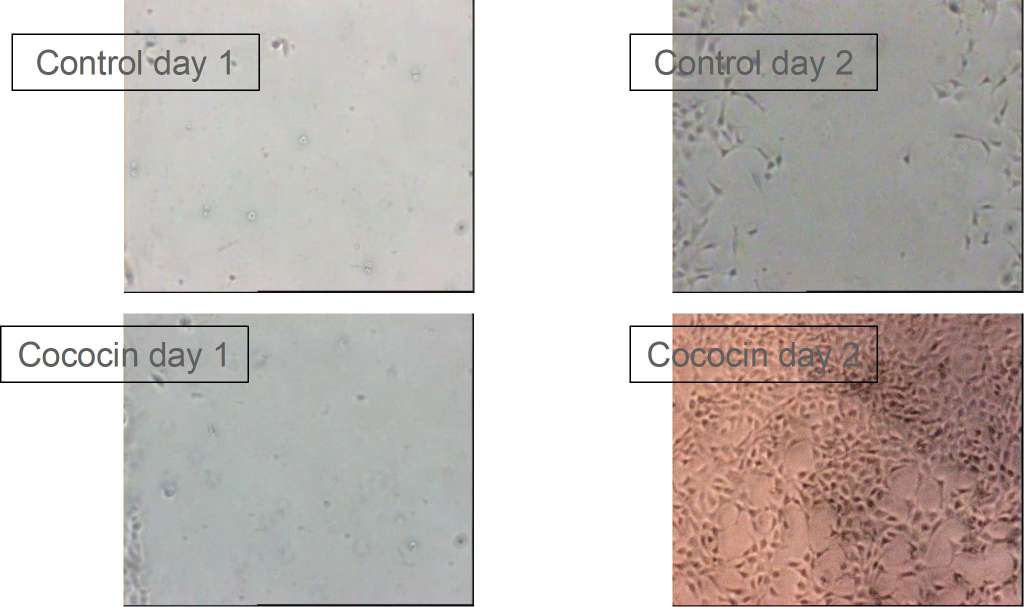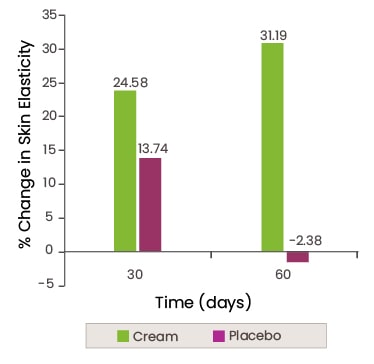The Nourishment Factor®: Cococin®
Support Hydration & Healthy Cell Growth
Cococin: Freeze-dried form of coconut water

Introduction
Coconut water, the liquid endosperm of green coconuts (Cocos nucifera), is a refreshing natural beverage, an oral rehydrating agent, and a supplement in nutrient media for tissue culture. Coconut water is often described as a “natural isotonic sports drink”, providing higher amounts of electrolytes such as potassium and magnesium than conventional sports drinks. Coconut water solids also have a prebiotic role, and beneficially influence the balance of microflora in the gastrointestinal tract. When topically applied, coconut water solids nourish the skin and hair, supporting healthy cell growth.
Cococin, The Nourishment Factor®* captures the goodness of coconut water in a convenient, free flowing, and powder form. Recently self affirmed GRAS for use in foods and clinically validated for its topical benefits, Cococin finds multifunctional applications in cosmetic, personal care and food and beverage compositions.
A patented lyophilization process produces a stable composition retaining the inherent biological activity of environment sensitive nutrients and growth factors in coconut water, and delivers these actives in optimal amounts. The amorphous nature of the solid produced by this process protects the protein components and environment sensitive actives during subsequent pulverization and storage. During storage, the material transforms to the more stable, less hygroscopic, crystalline state.
Cococin blends seamlessly with cosmetic compositions, and easily disperses in water, making it a compact and versatile nutrient pool for use in topical formulations, as well as in functional foods and beverages that nurture from the inside out.
Green Coconut Water: Nutritionally Versatile
It is important to differentiate between coconut milk and coconut water. The first is a sweet, milky white cooking base taken from the flesh of a fully developed coconut, while the latter is the liquid endosperm of the coconut. The liquid endosperm is sometimes incorrectly called coconut milk; however, this terminology comes from the French term ‘lait de coco.’ The correct term is coconut water, not coconut milk.
The ratio of RNA-phosphorus to DNA- phosphorus is significantly lower in the liquid endosperm of mature coconuts as compared to that of green coconuts. RNA plays an important role in amino acid transport and respiratory metabolism in living cells. Coconut water used to make Cococin is obtained from green coconuts at the optimal stage of maturity, to ensure a high content of RNA and growth factors, including shikimic acid, quinic acid and indole-3-acetic acid, along with essential vitamins, amino acids, and minerals.
The coconut is unique in that it contains large amounts of liquid endosperm for a year or more of its life. The largest quantity of the liquid endosperm, coconut water is however contained in young green coconuts, and it delivers vital nutrients for sustained development of the solid endosperm (coconut meat) found inside the fruit.
At the completion of growth, the solid endosperm and the last of the coconut water provide nourishment for the forming embryo and seedling. Thus, coconut water serves the role as a reservoir of nutrients to support tissue growth (Tulecke, et al., 1961).
The liquid is rich in proteins, amino acids, sugars, vitamins, minerals and growth factors (Table 1) with pivotal roles in supporting tissue growth. Shikimic acids and quinic acids have been found in extracts of coconut water obtained from fruits at various stages of development, with the greatest amounts being found in young, green coconuts. These alicyclic acids participate in aromatic biosynthesis, and are therefore significant in the growth and development of the budding coconut. These compounds along with identified cytokinins also play an important role in the nourishment and growth of plant and animal cells.
| Compound | Mg/L |
|---|---|
| Nicotinic acid | 0.64 |
| Pantothenic acid | 0.52 |
| Biotin | 0.02 |
| Riboflavin | 0.01 |
| Folic acid | 0.003 |
| Thiamine | Trace |
| Pyridoxine | Trace |
| Auxin | 0.07 |
| Gibberellin | * |
| 1.3-Diphenylurea | 5.8 |
| Sorbitol | 15.0 |
| M-inositol | 0.01 |
| Scyllo-inositol | 0.05 |
| Compound | Mg/100g |
|---|---|
| Potassium | 312.0 |
| Chloride | 183.0 |
| Sodium | 105.0 |
| Phosphorus | 37.0 |
| Magnesium | 30.0 |
| Sulfur | 24.0 |
| Iron | 0.10 |
| Copper | 0.04 |
Table 1: Vitamins, Growth Promoters, Sugar alcohols, and minerals in coconut water (Tulecke, et al., 1961)
The amount of RNA-phosphorus (RNA-P) in coconut water was discovered to be consistently high in green coconut water (Table 2, Tulecke, et al., 1961). The role of RNA in amino acid transport and respiratory metabolism of living cells is well known. The RNA of coconut water would therefore efficiently support the metabolic mechanism vital to the budding endosperm tissue of the coconut, and sustain the growth of other living cells as well, in tissue culture.
| RNA-Phosphorus and DNA-Phosphorus of The Alcohol-Insoluble Residue from Coconut Water | |||
|---|---|---|---|
| μG/mg alcohol-insoluble residue | Ratio | ||
| Age of coconuts | RNA-P | DNA-P | RNA-P/DNA-P |
| Young green | 20.05 | 0.06 | 342.5 |
| Mature, green | 32.82 | 2.45 | 13.9 |
Table 2: RNA-P to DNA-P ratio
Coconut water has been used in the tropics as a nutritive and rehydrating agent to restore electrolyte balance in cases of diarrhea (Adams, et al., 1992). A published research report mentions that coconut water can be used as a short term intravenous (IV) fluid (Campbell-Falck, et al., 2000). Other reported applications include use in total parenteral nutrition (TPN) (Petroianu, et al., 2004), and sports beverages (FAO, 1998).
Coconut water is described as an isotonic sports beverage. A comparison of coconut water with regular sports beverages is presented in Table 3 (FAO, 1998).
| Component | Sports drinks (Mg/100 ml) | Coconut water (Mg/100 ml) |
|---|---|---|
| Potassium | 11.7 | 294 |
| Sodium | 41 | 25 |
| Chloride | 39 | 118 |
| Magnesium | 7 | 10 |
| Sugars | 6 | 5 |
Table 3: Sports Drinks vs. Coconut Water
Coconut water solids, as found in Cococin, are known for their nutrient-rich profile, which supports the natural growth and maintenance of human tissues, including hair follicles, as suggested by preclinical trials. This makes coconut water an ideal ingredient for revitalizing products aimed at the care of skin, hair, and nails. Cococin contains a blend of essential nutrients beneficial for overall wellness, including 324 mg of Calcium, 3050 mg of Potassium, 206 mg of Magnesium, 4.3 mg of Iron, 6.4 mg of Vitamin C, and approximately 4.6 g of Protein per 100 g, alongside natural sugars and fatty acids. Such a nutrient composition contributes to supporting the body’s natural structure and functions.
Formulating Cosmetics and Nutricosmetics Containing Coconut Water Solids
A proprietary lyophilization process produces a stable composition of coconut water with its inherent biological activity preserved (US Patent No European Patent No. 1341547). The process is designed to produce an amorphous solid, which is easy to work into food and personal care formulations. Protein components and environment sensitive actives are protected by the amorphous nature of the solid, during subsequent processing. During storage, the material changes to the more stable, less hygroscopic, crystalline state.
In preparing the proprietary lyophilized composition Cococin, green coconuts are harvested at the right stage of maturity to guarantee optimal content of RNA and growth factors, including shikimic acid, quinic acid and indole-3-acetic acid, essential vitamins, amino acids, and minerals.
The proprietary freeze dried coconut water solids blend seamlessly with dry products, and readily dissolve in water. Cococin is thus The Nourishment Factor that provides a valuable nutrient pool for enhancing food and beverage, as well as cosmetic product formulations. On account of its GRAS status, Cococin can be safely used in oral care as well as lip care compositions, to support hydration and tissue health.
Preclinical Studies Showing the Efficacy and Safety of Cococin
Role of Cococin in Healthy Cell Growth and Proliferation:
Cococin was used in the growth medium for fibroblast cell lines in an in vitro study. Cell proliferation was significantly enhanced in cells treated with Cococin containing nutrient medium as compared to controls receiving standard nutrient medium.
Cell Proliferation Enhancement by Cococin in Swiss 3T3 Fibroblast Cell Line

Clinical Study Showing the Efficacy in Reducing the Appearance of Skin Aging
Twenty-two females in good health of ages 20-35 years old were subjects in a double-blind placebo-controlled clinical study (Research Report Sami Labs Ltd., 2005). A cream containing 1% coconut water solids (Cococin INCI: Cocos nucifera (coconut) fruit juice, with other natural ingredients) was applied onto the left arm of each subject, and the cream base was applied onto the corresponding area of the right arm, to serve as control. 200 mg of the cream and cream base was applied daily for eight weeks, to the marked areas on the left arm and right arm respectively.
Percent reductions in skin roughness and modifications in skin elasticity were used to evaluate the product. Skin roughness was evaluated using a skin visiometer and dermal elasticity was measured using a cutometer. The percent decrease in skin roughness and change in elasticity effected by the cream and cream base were compared (Figure 1).

Effect of Cococin on the Parameters of Skin Aging
The study found that the use of a cream containing Cococin was associated with improvements in skin elasticity, leading to a reduction in skin roughness and enhancement of skin tone. Cococin is shown to nourish keratinous tissue and support skin tissue integrity, which may contribute to maintaining the skin’s healthy appearance and minimizing the visible signs of aging, including wrinkles
* Research report, R-Tech labs, March 2008
Conclusions
Cococin can effectively be used for oral and topical applications and serves as a natural pool of nutrients and growth factors that support body’s natural aging process. Contact Sabinsa Corporation for further information, samples and formulation guidelines, with reference to cosmetics and nutricosmetics.
References
- W. Tulecke, et al., Contributions from Boyce Thompson Institute, 1961, 21:115-128
- W. Adams, et al., Trop Geogr Med 44, 149-53 (1992)
- D. Campbell-Falck , et al., Am J Emerg Med 18, 108-11 (2000)
- GA. Petroianu, et al., J. Trace Elements in Experimental Med. 17, 273-82 (2004)
- T. Kuberski , et al., N Z Med J. 90, 98-100 (1979)
- FAO: Agriculture 21, New sports drink: coconut water. October 1998
- Majeed, M and Badmaev V. Coconut Water and Its Method of Preparation. EP1341547
- Coconut and health- a literature review. Secretariat of the Pacific Community 2003.
http://www.spc.org.nc/Lifestyle/frames/links/Detailed%20coconut%20-%20final.doc - Sami Labs Ltd. Research Report, unpublished. (2005)
